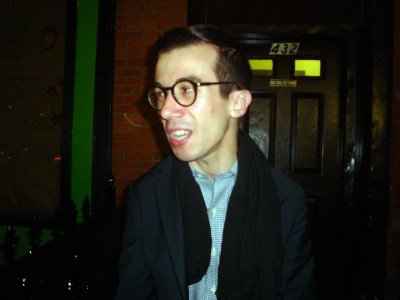
João Ribas, Curator and Critic
To address the conditions of curating contemporary art, one must address the temporality it inhabits. This was one of many currents in a recent lecture at The Glassell School of Art by João Ribas, Co-Curator of the current Stan Vanderbeek exhibition at the CAMH and Curator at the MIT List Visual Arts Center. In a four-part lecture, Ribas attempted to define the profusely used term “contemporary” in emerging art practices and particularly in relation to current exhibition practices. Here are some notes, fragments and impressions:
1. contemporaneity as a repository of time
2. Hal Foster: “The term ‘contemporary’ seems to shake off all historicism, and thus floats somewhere outside of “historical determination, conceptual definition and critical judgment.”
3. “Contemporary” is not just a term from post-war art, but documents a shift in art practice.
4. The concern of the October Revolution was to simply let everything be temporary.
5. Contemporaneity is determined with ways of being with and in time.
6. Documenta 12: “Is modernity our antiquity?”
7. Post 1989, the birth of contemporary and the beginning of the end.
8. Example… 1989: “The End of History?” essay by Francis Fukuyama
9. Curating is just one sect in which we see how the contemporary is being symbolized and historicized.
10. The process of recovery is a contemporary one.
11. We think those omitted constituencies are important so we need to find a narrative that will subsume them.
12. Pierre Nora: “A historicity that does not know what to do with the historical past, reflects our need to keep everything hence the obsession with the archive, that marks our age.”
13. The preservation of such a totality of the past… obliterates the present into the future. The recent emphasis on archival, revisionist art speak is what Hal Foster calls the “archival impulse”.
14. exhibition practices as the archive
15. the economics of attention that comes with an overemphasis/ overabundance on/of information
16. The converse of archiving is amnesia.
17. Post 1989, a contemporary art “movement” is relational aesthetics. The way in which this work fails immensely is that it forgets.
18. Maria Lind: “the social turn”
19. The realm of art practices situated in the social are institutionalized by 2008.
20. Example… 2008-09: The Guggenheim presents “theanyspacewhatever”
21. the need for new methodologies and social terms in exhibition practices
22. Artists aren’t interested in continuing a linear or normative art-historical narrative through the continued production of images.
23. In the field of curatorial practice, curators are actively trying to find new models for what an art institution should be which reflects the shift in practice among artists.
24. the role curatorial work plays in the contextualization and eventual historicization of contemporary artistic production
25. There was a rise of new kinds of art that challenged the normative assumptions of precisely that historical narrative. Those methodologies were, and continue to be, largely put in place by new generations of curators working with new generations


